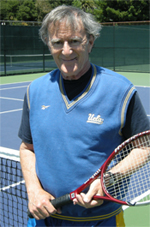A Comment on Straight and Locked Elbow Forehands
Paul Cohen
In the last decade, seemingly out of nowhere, the two greatest tennis players of the modern generation, Rafael Nadal and Roger Federer reintroduced locked elbow forehands in the pro game. Fernando Verdasco also hits a locked elbow forehand.
Before Nadal and Federer, Stefan Edberg was the last great player to hit a forehand with a locked elbow in the late 1980s and early 1990s. But this was a continental grip version of the stroke.
Locked elbow Continental forehands were actually prevalent from Rod Laver, to Tom Okker, to Lew Hoad, to Ken Rosewall, to Arhtur Ashe, and Illie Nastase, before Edberg. In the modern game, however continental forehands are virtually a thing of the past.
So where did the modern locked elbows come from? Should we copy them? In 60 years I can only remember 4 great locked elbow forehands: Laver, Okker, Nadal and Federer. Although it is impossible to deny their effectiveness, they are an extreme rarity, and associated with the genius of individual players.
Why? I believe that a locked elbow forehand offers the player less support behind the racket and for this reason is inferior to a bent elbow forehand. The locked elbow makes it more difficult to generate leverage on the ball consistently and without increasing the risk of error.
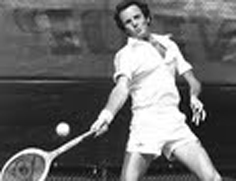 |
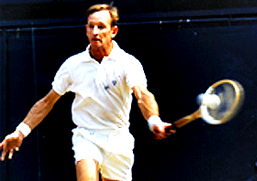 |
The last two great locked elbow forehands: Tom Okker (left) and Rod Laver (right). |
|
You can do a very simple experiment to prove this to yourself. Stand by a net post and lean against it with the palm of your hand, bending your elbow. You will feel the strength of your bent elbow as it supports your entire body.
Now lean against the same net post with a locked elbow. You have little strength because your arm will not support your body in the same way.
My belief is that without a bent elbow and your hand more behind the racket handle, you will not have adequate structural support to hit forehand with consistency, regardless of which grip you use.
The locked elbow forehands lack leverage because they are hit further away from the body - further to the outside and further in front. Particularly with the relaxed, high speed swings in the modern game, this requires exquisite timing.
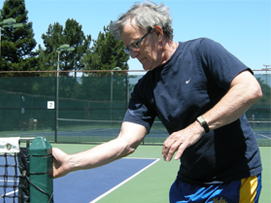 |
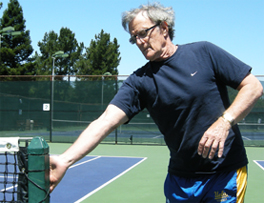 |
A simple test shows the greater support of a bent elbow forehand (left), compared to a locked elbow (right). |
|
Given the velocity, spin and extreme body rotation involved, the positioning of the racket at contact must be perfect. This is far more difficult with the straight elbow forehand.
A very slight error can render the stroke dysfunctional because the support from the bent elbow is non-existent. And control and solidity at the contact point are the keys for forehand play. This explains why both Federer and Nadal have some of the most egregious miss hits in tennis history.
Some coaches believe the straight elbow, combined with the shoulder generated windmill swings, creates more leverage and power. But history tells us that 98% of all tennis players on both the men's and women's tour today hit bent elbow forehands. As noted, there have only been a handful of great locked elbow forehands over the years.
In my opinion, what goes for the tour players, goes that much more for club players, recreational players and competitive players at all levels below the very highest in the pro game. The fact is that the bent elbow forehand is very natural in the sport of tennis.
Novak Djokovic's forehand contact point is with the elbow bent, as is Robin Soderling's. As John Yandell pointed out in his first article on Djokovic's forehand, Novak also hits with a similar under the handle grip to Nadal, but is still able to play up close to the baseline like Federer. (Click Here.)
It can be argued that both of these forehands are at the same level as either Nadal's or Federer's. In fact, as the Wimbledon final just showed, Djokovic was able to do far more damage to Nadal with his forehand compared to Federer in recent matches.
On grass at Wimbledon and also in his hard court wins earlier this year, Djokovic consistently hurt Nadal going crosscourt to Nadal's backhand, breaking off short angles that made it impossible for Nadal to run around the ball and try to use his own forehand to take control.
My belief is that is it best to learn your bent elbow forehand with support and control at contact point. When Raphael Nadal hits a 100 mile per hour forehand down the line for a winner, leave that style to the genius. It might not really be a superior shot anyway.



